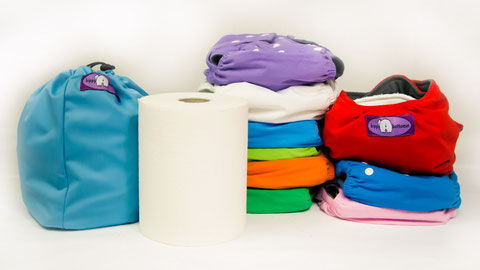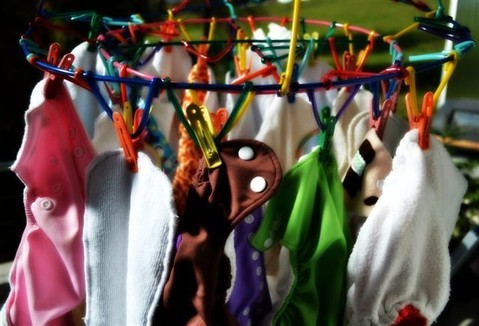How to use

General Use
What do I do with the inserts?
The inserts are placed inside the pocket. Usually one insert is enough, but you can also use more to increase absorbency (this is especially useful of a night).
Do you recommend the Stay Dry or the Mixed Nappies?
I love to use the Mixed Nappies during the day, because of the beautiful fabrics against my babies skin, and then the Stay Dry Nappies during the night, so that my baby doesn’t get nappy rash from wearing the same nappy all night (as these stay dry against the skin as the name suggests). Sometimes I use a microfibre insert in the pocket of a natural nappy, so that the insert dries fast, but there is a beautiful fabric against my babies skin.
How do I adjust the size?
The size is adjusted with the bottom 3 rows of snaps (9 snaps in total)
+ + + row 1
+ + + row 2
+ + + row 3
=> for small size - fold the bottom row of snaps (row 3) up and clip them into row 1
=> for medium size - fold the middle row of snaps (row 2) up and clip them into row 1
=> for large size - leave all 3 rows unsnapped
The other snaps are used to adjust the size around the waist (very top row) and around the legs (second row from top).

Washing and dishing
Q: Should I wash the nappies before their first use?
A: Yes, you should wash them 5-6 times. This will allow them to reach peak absorbency (think of them like a new towel)
Q: How much detergent should I use and what brand do you recommend?
A: Use ½ strength detergent (if you use too much detergent it will leave a film on the nappy and lead to leakage). Any natural brand that doesn’t contain bleach, enzymes or fabric softeners.
Q: What temperature should I wash cloth nappies?
A: It is best to do a rinse cycle first, then wash with cold, warm or hot water (max 60°C) and then cold rinse to finish.
Q: What is the best way to dry cloth nappies?
A: In the sun – sunlight naturally bleaches the nappies to remove any remaining stains. But, you can also dry them in the dryer as long as the temperature is not too hot.
Q: Should I soak my cloth nappies?
A: No. Soaking will wear out the cloth nappies faster. We do not recommend Napisan. You should just store them in an airtight container and wash them within 3 days.

Q: Should I remove solids before putting the cloth nappy in the airtight container?
A: Yes, you should rinse off majority of the solids. You can also use nappy liners to catch solids (these can then be placed directly in the toilet, as they are biodegradable). Another option to avoid pooey nappies is to potty train from birth (see bottom of this page).
Q: Why can’t I use fabric softener?
A: Fabric softener can decrease the absorbency of the nappies. A natural alternative is vinegar.
Q: Why can’t I use bleach?
A: It will wear the nappies.
Q: Can I use barrier creams or powder on my baby?
A: You shouldn’t use barrier creams, but powder is fine.
Q: How do I do a strip clean on my nappies?
A: First wash your clean nappies in hot water (60°C) with no detergent filled up to a high level. Then wash your nappies again using a small amount of dishwashing liquid (yes, the one you use on your dishes - one that has no moisturiser). Rinse as many times as necessary to remove any suds.
Leaking
Q: My cloth nappies are leaking. What could be the reason?
A: The following are possibilities:
1) You have not done up the nappy tight enough around the stomach or legs.
2) The insert is bunching.
3) You haven’t prewashed your nappies enough.
4) There is clothing pushing up against the absorbent part of the nappy, causing wicking.
5) You have left the nappy on too long – change more frequently or add an insert.
6) You have used too much detergent, creams or fabric softener and they have left a film on the nappy. In which case you will need to do a strip clean (see above).
Potty Training from birth
Elimination communication is a toilet training practice in which a caregiver uses timing, signals, cues, and intuition to address an infant's need to eliminate waste.
From birth you should start to make a sound (or say a word) when your baby is doing a poo so that your baby starts to associate the sound with the action of going to the toilet. With the time, your baby can express itselfs when it's time. Signs might be fluffing, or facial expressions (pushing etc) or they might always do a poo at a similar time of the day or maybe as soon as they wake up.
